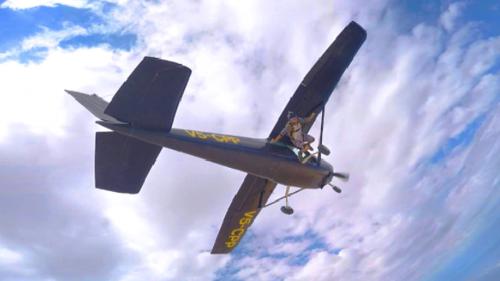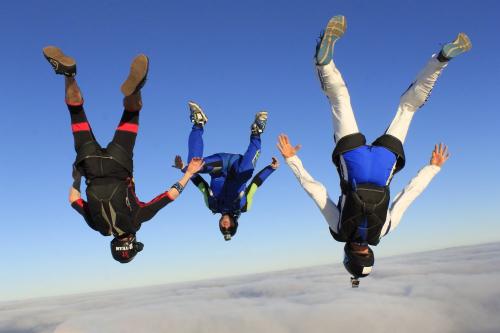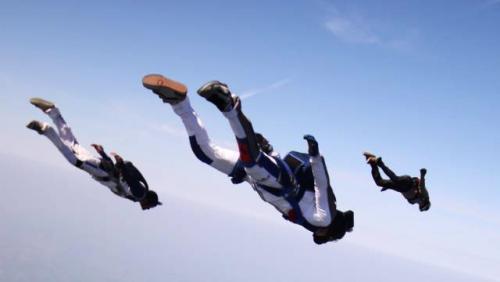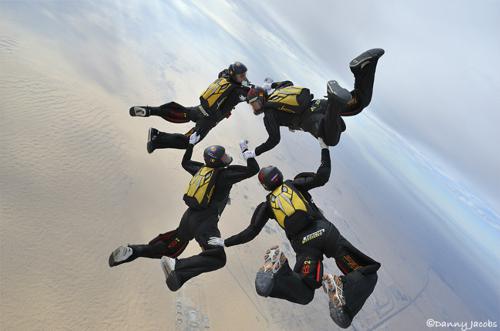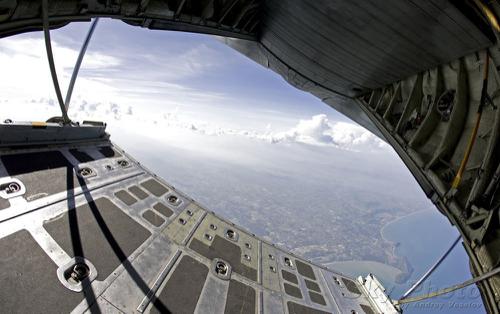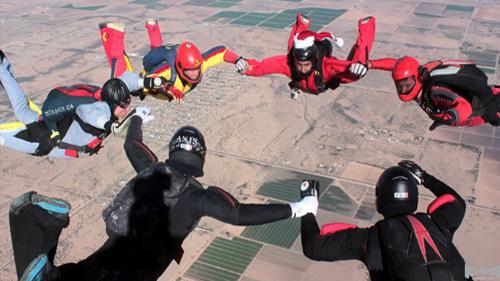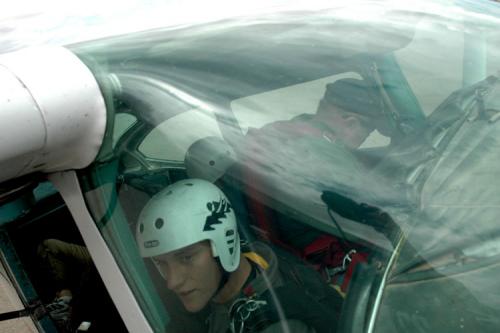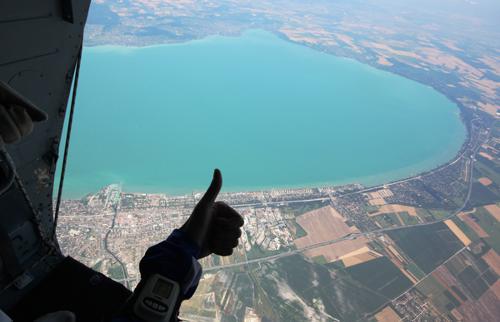by Bryan Burke
Images by Serge Shakuto
Friends, co-workers, and visitors to Skydive Arizona often comment on my interest in environmental topics and my rather restrained consumption of goods and energy, at least by American standards. This is in sharp contrast to my job, which is helping to run the biggest drop zone on the planet. I freely confess I have probably pumped more jet fuel into jump planes than anyone on earth. My fuel supplier is on speed dial and I order 8,000 gallons of jet fuel with a 15 second phone call. When things are busy I make that call two or three times a week. National Championships or Holiday Boogie busy? Every other day.
Yet we strive to keep our operations as efficient as possible. This is good business: burn less fuel, save money. Over time, every incremental gain in efficiency saves a few gallons of fuel here and there, just as people who plan their weekly driving to minimize miles and maximize efficiency will see huge savings over time, in thousands of small increments.
I reconcile my environmental leanings with my job in this manner: if someone else was doing it, a lot more fuel would be wasted. On a busy day I figure my expertise and commitment to efficiency saves Skydive Arizona at least two Otter loads worth of fuel consumption.
Just how much does our sport consume, and how does that compare to other ways oil is used or wasted? The numbers that follow are rough - sometimes very rough. Comparisons are difficult because as numbers get bigger and bigger, they tend to get harder to evaluate for accuracy. Even rough numbers will give the curious reader something to think about.
A Twin Otter burns about 30 gallons of jet fuel per load. If a drop zone operates at high efficiency, meaning most loads are close to full, that works out to about 1.4 to 1.5 gallons per jumper through the door. Other jump aircraft can be assumed to come in somewhere near that figure. A Cessna 182 burns a lot less per load in volume, but in terms of jumpers per load and time flown, they aren’t that different. Single engine turbines are probably about as efficient as it gets. But on the other hand, if you lose an engine on an Otter, you’re still in an airplane. If you lose the engine on a PAC or Caravan, you’re in a glider. That’s the main reason Skydive Arizona likes to run twin engine jump ships.
Gasoline turns into Carbon Dioxide at a rate of about one gallon into 20 pounds. Jet fuel is a little less clean, coming in at 21 pounds per gallon. Therefore, for every 100 jumps you make, about 140 gallons of fuel are burned, and 2,940 pounds of carbon dioxide are emitted. That’s one and a half tons. Does your log book suddenly feel heavier?
If you are having trouble wrapping your head around this figure, think about the raw energy involved in getting to altitude for a skydive. Imagine climbing 13,000 feet on foot, say from the lowlands around Mt. Rainier to the summit, which is 14,411 feet above sea level. Skydive Arizona is 1,500 feet above sea level, so when your altimeter says 13,000 on jump run, you’re at about the same height as the summit of Mt. Rainier. It would take several days, lots of meals, and enormous effort to get to that summit on foot. We do it in 15 minutes using a jump plane. How? By turning long dead plants and animals into explosive energy funneled through a turbine engine.
By USPA’s figures, approximately 3 million jumps per year were made in the USA between 2007 and 2016, which works out to 4,200,000 gallons of fuel and 88,200,000 pounds of CO2. That’s 44,100 tons of CO2 emitted by skydiving in America each year. Multiply that by ten years and we’re talking about a lot of emissions!
Let’s look even further back. Based on the jump estimates published in the April 2013 edition of Parachutist, annual jump numbers were at or below 2,000,000 until the late 80s, then climbed steadily throughout the 90s to their current levels. This makes sense. Prior to 1990, turbine aircraft were few, equipment less reliable and “one size fits all,” and training less sophisticated. People packed their own rigs. The pace was just a lot slower. Improvements in all these areas allowed the sport to reach out to a much broader demographic, resulting in more jumps made.
Driven by curiosity I started pulling numbers off USPA’s bar graph estimating number of jumps per year through 2013 and then added on through 2016. I made my best rounding-off estimate, coming up with about 70 million jumps in the history of US skydiving through 2016.
Obviously as data gets harder to read, or scarcer, numbers get fuzzier. Rough numbers suggest that about half of all jumps made in the world take place in the USA, so globally the skydiving total might come to about 140 million jumps made in the entire history of the sport.
That would mean that since 1960, the sport has burned through somewhere around
196,000,000 gallons of fuel, sending about 2,058,000 tons of CO2 out the exhaust pipes.
How do we stack up against other fuel figures?
The State of California estimates that 26,221,917 gallons per year are burned by Off Highway Vehicles, including motorcycles, ATVs, and snowmobiles. That’s almost six times the total national fuel consumption for skydiving. Put another way, OHV recreation in California alone burns more than twice as much fuel as the entire world’s skydiving.
The Department of Defense is the world’s single largest buyer of fossil fuels, with an estimated consumption as high as 14 million gallons per day. That’s more than all skydivers in the world use in a year and a half.
To fly Air Force 1 to Hawaii and back is about 50,000 gallons of fuel, or about 36,000 jumps – enough fuel to run a mid-sized seasonal drop zone for a year.
So much for motorized comparisons. Let’s look at some other fossil fuel uses.
In my home state of Arizona coal-generated electrical power produced 33,402,462 tons of CO2 in the year 2016. In just one year, that works out to 16 times the entire skydiving fuel burn, globally, in all of history.
The Earth Policy Institute estimates that America’s bottled water demand requires 714,000,000 gallons of oil annually for materials, packing, storage, transport, and cooling. That works out to more than 80 years of jumps for the entire skydiving world at current levels of jumping.
In a more graphic image, the Pacific Institute says each bottle of drinking water would have to be filled about ¼ of the way up with oil to represent the energy it used! A gallon is 3.8 liters (which makes one jump about 5.3 liters, don’t you love math?) so you only need to drink about twenty-one 1-liter bottles of water or other beverages to waste as much oil as one skydive. Of course, this doesn’t count the energy used to get you to the DZ and make your rig, jumpsuit, and accessory equipment. Or make the airplane, pave the runway, and put up the hangar.
Then comes the most disheartening element of fuel of all, the waste.
The Exxon Valdez spill released about 11,000,000 gallons of fuel over the space of a few days, enough to supply the entire global fleet of jump ships with fuel to fly for over a year. Exxon Valdez pales compared to the ten largest spills in history, all of which amounted to more than 45 million gallons each. The Deepwater Horizon spill alone was estimated to be approximately 200 million gallons, which would cover all the skydives ever made in the world, with about 30 million gallons left over for rigs and jumpsuits, and shipping them to customers.
Here’s my favorite. Around three billion gallons of gasoline are estimated to be wasted annually in the USA by cars idled in traffic congestion. If that amount was used for skydiving, the entire world could keep jumping at current levels for another 350 years. Daily fuel wasted in American traffic jams is the equivalent of almost six million jumps, or an entire year of the entire world’s estimated skydives.
I didn’t bring up all these very dark comparisons to make skydiving look green against a black background. There’s just no way we can rationalize skydiving into being green. To visualize just how much CO2 you generate on each jump, take that 29.4 pounds of CO2 and visualize it as six five-pound bags of charcoal briquets. Every jump, piling up on the DZ. If a bag of briquets is about one cubic foot, even a small drop zone would have a big pile out back. Skydive Arizona would have enough to fill four structures the size of the Colosseum of Rome, plus one Parthenon.
On the other hand, clearly skydiving is a small element of the whole picture. At the personal level, if you are the average American your annual car emissions are the equivalent of 340 skydives per year.
Even so, how can it be justified?
Philosophically, I do it this way. Play is a fundamental need coming in right after food, water, shelter, and security. Skydiving is high quality play, as good as it gets, but it comes with a cost. We can’t eliminate that cost, but we can mitigate it by simply focusing on eliminating waste and inefficiency throughout our society and off-setting the damage through environmental restoration.
Wasteful use of oil, such as bottled water, cars stuck in traffic, industrial scale agriculture, consumer culture in general, and incredibly fuel consumptive military adventures around the globe are examples of where savings could be had. These require some personal and political commitment to steer away from a system that practically glorifies waste. Why not take that lesson skydiving with you? Maybe carpool to the DZ with a friend. Take an apartment closer to your job to avoid that wasteful commute or use mass transit to get to work. Buy a couple re-useable five-gallon water jugs to fill at a local water filtration facility, then refill smaller bottles from that rather than buying a pack of one-liter bottles for the weekend at the DZ. Set your air conditioning a little higher in summer and a little lower in winter. Make your driving as purposeful and efficient as possible by planning your errands carefully and buying a car that is practical rather than a statement about image.
Buy less stuff. Not only does stuff need to be moved from source to consumer, it must be mined, refined, transported to manufacturing plants, and so on. An I-phone 5S has a carbon footprint of 150 pounds - five skydives worth of fuel.
I find that visualization really helps me make immediate choices. If you visualize the bottom quarter of that throw-way beverage bottle as filled with bitter jet fuel that you must drink, you’ll never want to touch it again. Sodas, same way. All that high fructose corn syrup was grown on highly mechanized farms before it was heated, treated, dyed, stuffed into a plastic bottle, and trucked to its air-conditioned home in a machine! When I contemplate a road trip, I visualize chucking a five-pound bag of charcoal out of my window every five miles and ask myself just how important that trip is to me. It’s harder to hide from the truth this way. I’ll still make the trip, but I allow myself only so much total annual fuel consumption – a budget, if you will – and making that trip will require that I tighten up consumption in other areas. Most Americans could reduce their overall consumption of energy, goods, and services by at least a third with a little thought and better practice.
Finally, don’t waste money and fuel on lousy skydives! Focus on well planned jumps that have a high probability of success and the feeling of reward that comes with that. You’ll learn faster, be safer, and maybe be just a tiny bit greener too! There’s an old saying, “Dirt dives are free.” Use your time on the ground wisely and your time in the air will be well spent.

